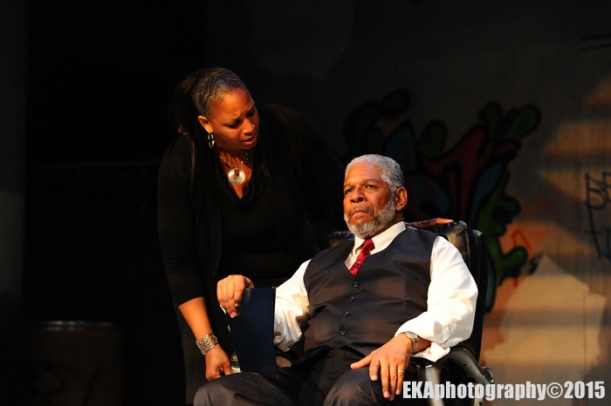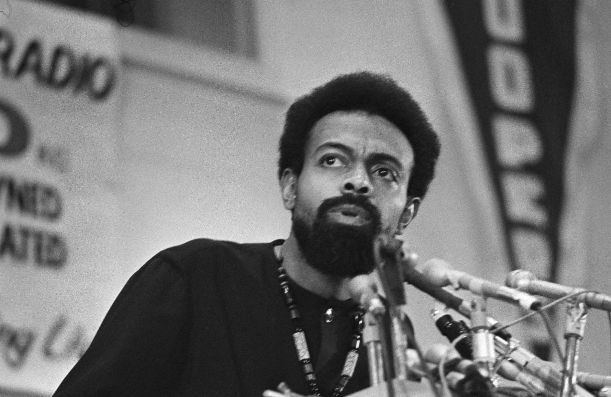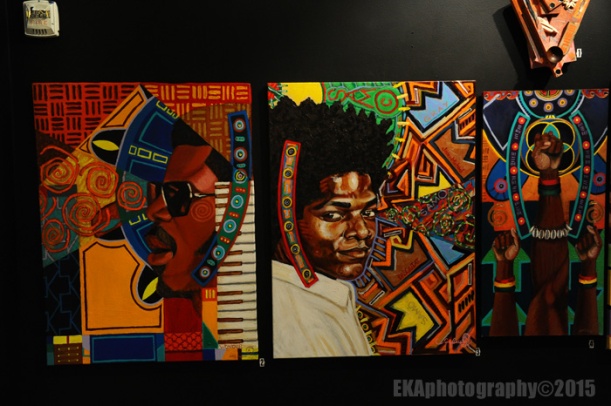
What does “home” mean? Is home where the heart is? Where the hatred is? A physical location? A state of mind? Can prison be a home? What does it mean to come home? And, can you ever really go back home again? These philosophical questions are at the core of the Lower Bottom Playaz’ production of “Beyond the Bars: Growing Home.”
In “Beyond the Bars,” the prison-industrial pipeline becomes a backdrop for an powerful examination of black masculinity . An array of black men, ranging in age from mid-20s to senior citizen, come together regularly to check in with their feelings. It’s somewhat telling that the vehicle which allows them to gather for this purpose is a re-entry support group; all of them are formerly-incarcerated.
The prison-industrial pipeline becomes a backdrop for an powerful examination of black masculinity
Their check-ins are largely about dealing with the ramification of their imprisonment, from the horrors and injustice they’ve witnessed behind bars, to their own acknowledgement of guilt and responsibility for their actions, to their struggles with social inclusion, employment – and potential retribution by the relatives of their victims. It’s a set-up which allows a murderer to reveal their motivations in one breath, then argue against the perpetuation of cyclic violence in the other.
The cast represent the so-called thugs and black bogeymen vilified in conservative political rhetoric and sensationalistic media portrayals, but such stereotypical perceptions are entirely superficial in this context. The cyclic patters of crime, incarceration, and recidivism are not entirely the result of personal choices these characters have made, but moreso collective examples of how structural inequity plays out. As the play unfolds, we learn more about the characters, which makes it difficult, if not impossible, to dehumanize and demonize them.
The re-entry support group functions as a place where the “cool pose” of black male attitudes are examined and analyzed, revealing a vulnerability and strength rooted as much in resilience as in systemic oppression.
While this is ironic, it’s not a completely-implausible scenario; One in three African Americans are incarcerated in the United States (a statistic which also held true in a post-performance survey of the cast). So, the set-up works. The audience eavesdrops in as a moderator facilitates the meetings, sometimes attended by a doctor who is collecting stories for research.
The cyclic patters of crime, incarceration, and recidivism are not entirely the result of personal choices these characters have made
What follows is a poignant, nearly 90-minute deep dive into how the prison-industrial pipeline has become an integral part of black life. Each of the formerly-incarcerated characters are presented as flawed, yet human. Each has redeeming qualities which can be easily overlooked, or more accurately, swept aside by preconceived notions about the correlation between crime and race.
 The play forces viewers to examine those preconceived notions, and to confront the reality of the situation, just as the characters must all confront their uncertain futures outside of jail. “I paid the price. I own the fault… Let me get right,” one of the characters says. It’s a line which suggests redemption is as much about acceptance as repentance. If we believe in rehabilitation, we must allow for re-entry into society, the play argues, undergirding its argument with the alarming statistic than more Africican Americans are incarcerated today than were enslaved in 1863.
The play forces viewers to examine those preconceived notions, and to confront the reality of the situation, just as the characters must all confront their uncertain futures outside of jail. “I paid the price. I own the fault… Let me get right,” one of the characters says. It’s a line which suggests redemption is as much about acceptance as repentance. If we believe in rehabilitation, we must allow for re-entry into society, the play argues, undergirding its argument with the alarming statistic than more Africican Americans are incarcerated today than were enslaved in 1863.
A generational dynamic is introduced when a young adult joins the group. His antagonism and apathy create palpable tension; and his impulsiveness leads to a pivotal and climactic conflict which adds a gracenote of gravitas to the already emotionally-laden subject matter. The older ex-cons attempt to emphasize the senselessness of the “street soldier” mentality: they’ve been down that road before, and know what predictable outcomes await. But ultimately, the younger man must decide for himself whether to choose the path of violence, or turn the other cheek.
“I paid the price. I own the fault… Let me get right,” one of the characters says.
What’s most interesting about this production is the injection of socially-relevant commentary into a theatrical format. It’s the opposite of escapism; instead of zoning out into a fantasy drama, the production locks on to a stark reality, making a point that should be impossible for the audience to ignore.
Two additional elements to the production are the hip-hoppish original score by Young L, and two music videos by WolfHawkJaguar and Prosperity Movement which bookend the show. The former centers the play in a contemporary urban aesthetic, while the latter offers a fantastical, spiritually-grounded vision of aspirational positivity.
The stories themselves are fascinating as well (and are the product of actual research by LBP Executive Director and playwright Dr. Ayodele Nzinga, who also plays the Doctor). The actors all look like guys you might see around town on the streets. Costuming is fairly simple, with characters changing clothes to mark a different day.
 Dejon Grant is both venomous and compassionate in the role of Terminal Murder, while Stanley Hunt’s conflicted yet charismatic Young Man nearly steals every scene he’s in. Reggie Wilkins brings wisdom and dignity to the role of OG. That these actors shine is a testament to what they bring to the role, and how easy it becomes for them to inhabit these characters, to make them real in the eyes of the audience. Some of the other roles are less distinctly-individual, or slightly underdeveloped; we never get a sense of what drives the moderator to do this work, and the Doctor seems to be a stand-in for academia in general—a commentary on the poverty-pimp dynamic which throws millions of dollars at the problem of recidivism annually, without making any appreciable headway.
Dejon Grant is both venomous and compassionate in the role of Terminal Murder, while Stanley Hunt’s conflicted yet charismatic Young Man nearly steals every scene he’s in. Reggie Wilkins brings wisdom and dignity to the role of OG. That these actors shine is a testament to what they bring to the role, and how easy it becomes for them to inhabit these characters, to make them real in the eyes of the audience. Some of the other roles are less distinctly-individual, or slightly underdeveloped; we never get a sense of what drives the moderator to do this work, and the Doctor seems to be a stand-in for academia in general—a commentary on the poverty-pimp dynamic which throws millions of dollars at the problem of recidivism annually, without making any appreciable headway.
While the characters are all written with some distinguishing characteristics, there seemed to be more commonalities than differences between them. This might be a result of the methodology Nzinga employed to develop the production, gathering stories from multiple individuals which were divvied up between the characters. At times, the characters appear to blend into each other; this effect is reinforced throughout, as several particularly-emphatic lines are repeated in unison — evoking an Oakland version of a Greek chorus. Much of the dialogue has a prose-like feel (Ms. Nzinga’s research was supplemented by original poetry).
This approach ultimately injects a strong dose of realism and authenticity to the show. The actors all blend into their roles with the ease and comfort of a favorite shoe. The dialogue is accessible and conversational. While the frequent use of the N-word may seem jarring to some, it wouldn’t make logical sense for a group of formerly-incarcerated individuals to dialogue in non-colloquial, speech.
Several particularly-emphatic lines are repeated in unison — evoking an Oakland version of a Greek chorus
This point bears a little further elaboration. LBP productions, as Nzinga later explained during a post-show talk, honor the tradition and aims of the Black Arts movement, i.e., to create culture which is interconnected with liberation struggles and the push for social justice. So while the staging may be minimalist, it also doesn’t distract from the subject matter. While the costumes may be understated, the low-key aesthetic is consistent with the nature of the story being told. While the dialogue may be down-to-earth, it never comes off as pretentious.
Nzinga and the cast’s breaking of the fourth wall at the end–revealing themselves as activists/reformers—functions as a call to action, intended to stay with the audience as they return to the outside world. It’s the opposite of what can be expected from mindless entertainment, and a reminder that if black lives matter, the plight of the incarcerated and formerly-incarcerated matters a great deal.
###
“Beyond the Bars: Growing Home” runs through Sept. 3 at the Flight Deck, 1540 Broadway, Oakland CA
Tickets are here.


































